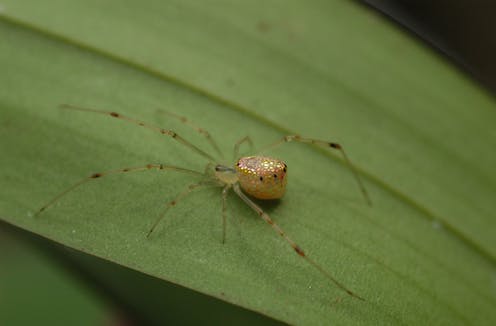Specimen of the spider Thwaitesia nigronodosa. Wikimedia Commons, CC BY-SA
A school in Gloucestershire, in the west of England, was closed for several days due to an “invasion of poisonous spiders”. Experts claimed they were not aggressive, but the school was closed, alarm spread and some media outlets were quick to call them “eight-legged monsters”.
In another case, the alleged severity of a spider bite on a woman triggered alarm in Mallorca (Spain). Social networks were flooded with messages and photographs of bites. Although the Conselleria de Salut and the leading hospital on the islands made it public that there was no health alarm and experts explained that no dangerous spiders are present in Mallorca, messages continued for days and days on social media.
Such news is likely to produce fear, a visceral reaction often sought by the most sensationalist tabloids. These stories do not remain in the local or regional press, but are disseminated on a global scale almost immediately.
The news carries with it political or social actions that can be costly, often unnecessarily so. For example, not taking children to school for several days or environmental pollution from unnecessary pesticide treatments. They also fuel a global sentiment based on misinformation: spider panic.
Contrary to the impression we get from reading these news stories, the risk of being exposed to a spider is minimal. Studies in Switzerland estimate that the annual probability of being bitten by a spider is between 10 and 100 cases per million inhabitants. Another study in Australia found that only 6% of confirmed spider bites were of medical importance.
The global spread of misinformation about spiders
A recent study by more than 60 researchers, published in the journal Current Biology, has examined the global spread of misinformation about spiders. This collective effort has resulted in the compilation of more than 5,000 news items on spider-human encounters published on the internet between 2010 and 2020.
The news items were evaluated in terms of their quality (presence or absence of errors) and their level of sensationalism.
Reporting errors and sensationalist language
Almost half of the news items analysed contained errors or inaccurate information, such as incorrect identification of the spider involved. Some articles report species that do not even live in the area, and sometimes there is no certainty that the bite occurred.
In up to 43% of cases, the news stories used sensationalist language. Although the language used in the news was less sensational when experts in arachnology had been consulted.
Errors often started at the regional level, and the story was amplified in national and international media. According to experts, this is a defining characteristic of modern misinformation: the amplification of small errors that support a false narrative. It is as present in spider news as it is in political news.
The likelihood of a country being a distributor of sensational news stories about human-spider encounters was positively related to several factors. These included the proportion of sensational news stories published in the country, the presence of spiders considered deadly, and a high number of internet users.
There are more dangerous spiders in Australia than in almost any other country, yet news about spiders is accurate and rarely emotionally charged. According to the analysis, the UK generates the most misinformation about arachnids, despite having very few dangerous venomous spider species.
The implications of the misinformation generated are no less significant. They reinforce a feeling of public animosity towards these arthropods. This leads to what we mentioned at the beginning of the article: the avoidance of their presence in public or private spaces, and the use of unnecessary pesticide treatments. Moreover, false alarms may lead to school closures or tourism suffering.
Shutterstock / MR.AUKID PHUMSIRICHAT
The other side of spiders
The first clear spider-like representations date back to 10,000 years ago. Because of their distribution, occupying all continents and habitats, as well as their biology and ecology, they have been admired and feared in equal measure.
They have often been associated with divinities, with creative powers (due to their great fertility, ability to make and weave silk and their cunning) and destructive powers (related to their hunting ways and the presence of poison).
All spiders, with the exception of the Uloboridae family, produce venom, but this, with rare exceptions, is imperceptible to humans. They use it, along with silk, to trap or immobilise their prey.
Only four genera of spiders have been described whose venom is of medical interest (Phoneutria, Loxosceles, Latrodectus and Atrax), and only 4% of the known species may be dangerous to humans. This means that of the approximately 45,000 known species, more than 43,200 are harmless.
Contrary to popular belief, spiders have many beneficial aspects. Firstly, they contribute to the total biodiversity of the planet, being one of the largest groups of invertebrate animals. In addition, they play an essential role in crop pest remediation due to their status as insect predators and are an important component of bio-indicators of environmental quality.
Once the criminalised view of arachnids has been debunked, the best thing to do when faced with a spider is to be kind to it, because it is a natural treasure.
Saioa Legarrea Imizcoz carries out her research work at the University of La Rioja thanks to the European Union Next Generation EU funds articulated through the María Zambrano call (Royal Decree 289/2021 of 20 April).
Tania A. García de la Parra Bañares does not work for, consult, own shares in or receive funding from any company or organization that would benefit from this article, and has disclosed no relevant affiliations beyond their academic appointment.
Related posts
SÍGUENOS
Ribera Salud y el precio del silencio: cuatro despidos para proteger un negocio que juega con la salud pública
Cuatro directivos alertaron de una “vulneración de derechos” y la respuesta fue el despido fulminante. Un sistema público secuestrado por la rentabilidad.
Extremadura entra en combustión política: Guardiola lanza un órdago para huir de Vox y puede acabar atrapada por su propia jugada
Un adelanto electoral presentado como gesto de autoridad puede convertirse en una trampa perfecta que devuelva a Extremadura al mismo bloqueo que dice querer evitar.
Cuando privatizar la salud significa calcular quién vive y quién no
Ayuso paga el negocio y la ciudadanía paga el precio
Vídeo | La DANA que arrasó Valencia y la política que se escondió detrás de una mochila
Marina Lobo desmenuza el caos, las mentiras y la cadena de irresponsables
La mentira humanitaria: cómo Occidente troceó Sudán para después fingir sorpresa
Quinndy Akeju explica la historia que los titulares evitan


 Seguir
Seguir
 Seguir
Seguir
 Seguir
Seguir
 Subscribe
Subscribe
 Seguir
Seguir




